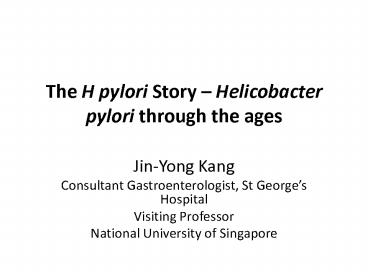The H pylori Story - PowerPoint PPT Presentation
1 / 24
Title:
The H pylori Story
Description:
The H pylori Story Helicobacter pylori through the ages . Jin-Yong Kang. Consultant Gastroenterologist, St George s Hospital. Visiting Professor – PowerPoint PPT presentation
Number of Views:111
Avg rating:3.0/5.0
Title: The H pylori Story
1
The H pylori Story Helicobacter pylori through
the ages
- Jin-Yong Kang
- Consultant Gastroenterologist, St Georges
Hospital - Visiting Professor
- National University of Singapore
2
Helicobacter pylori
3
Discovery of H pylori
- Bizzozero 1893 Spiral bacteria in canine stomach
- Krenitz 1906 Bacteria in human gastric cancer
- Doenges 1938, Greedburg 1940 spiral bacteria in
human stomach - These organisms cannot be grown
- Stomach relatively sterile environment
- Peptic ulcer thought to be due to excess gastric
acid and/or impairment of mucosal defence
4
Discovery of Helicobacter pylori
- Warren Consultant Microbiologist noted spiral
bacteria associated with histological gastritis - Marshall Medical Registrar cultured
Helicobacter pylori over Easter break - Completed Kochs postulates by ingestion of
Helicobacter pylori and becoming infected - H pylori cause of gastritis, peptic ulcer and
gastric carcinoma - Nobel prize in Physiology and Medicine 2005
5
History of H pylori
- Thought to have spread from East Africa,
birthplace of modern humans - Strains used to map history of human migration
- Gastric and duodenal ulcer disease became common
only in the 20th century - Ulcer prevalence declined since 1980, parallel to
decline of H pylori prevalence - Why did H pylori become pathogenic 100 years ago?
6
H pylori associations
- Histological gastritis
- Functional dyspepsia
- Peptic ulcer (duodenal or gastric)
- Gastric cancer
- MALT lymphoma
- CagA strains negatively associated with Barretts
oesophagus and oesophageal adenocarcinoma
(gastro-oesophageal reflux) - Non-GI idiothrombocytopaenic purpura, rosacea
7
Helicobacter pylori
8
Gastric ulcer
9
Gastric Cancer
10
Epidemiology of H pylori
- gt50 of world population affected
- Prevalence rates higher in developing countries
- Infection occurs in infancy and childhood
- In western countries older people more likely to
be infected association with socio-economic
situation during childhood e.g. hot water,
sharing of bedrooms - Re-infection in adult life said not to be common
11
Epidemiology of H pylori (2)
- H pylori prevalence in UK higher in older
individuals - Infection occurs during infancy and childhood
- Cohort effect older individuals acquire their
infection at a young age, when socio-economic
conditions sub-optimal - Younger individuals less likely to be infected
- H pylori prevalence decreasing, due to improving
socio-economic conditions - Peptic ulcer prevalence also decreasing
12
Natural history of H pylori infection
- Most individuals with H pylori asymptomatic
- All have histological gastritis
- 20 get dyspepsia
- 10 get peptic ulcer
- lt 1 get gastric cancer
- Eradication of H pylori can cure some patients of
dyspepsia, can cure or prevent peptic ulcer - Uncertain if treatment of H pylori in adult life
affects cancer risk
13
Diagnosis of H pylori
- Serology
- Urea breath tests C13, C12
- Stool Helicobacter antigen test
- Biopsy tests
- urease
- histology
- culture
14
H pylori diagnosis
- Serology (antibodies to H pylori) assesses
previous exposure, does not differentiate between
past and active infection - For all tests other than serology, proton pump
inhibitors within 2 weeks or antibiotics within 4
weeks reduces sensitivity of the tests - Eradication can be confirmed by stool antigen
test, urea breath test and biopsy tests
15
Urea breath test
16
Biopsy Urease Test for H pylori
17
Helicobacter pylori
18
H pylori infection is a special infectious
disease?
- Even with in vivo sensitivity antibiotics,
combination treatment is required, cure rates
relatively low - Antibiotic sensitivity data not easy to obtain
- Antibiotic sensitivity patterns vary with place
and time. More than one strain of H pylori in
the same patient. - Information on sensitivity patterns specific to
the country or area often not readily available
19
H pylori infection is a special infectious
disease? (2)
- Treatment outcome often not documented
- Regimens may be complicated, with many side
effects. Compliance often sub-optimal and can be
a major determinant of success - Intention-to-treat eradication rates may be lower
than per protocol rates
20
Treatment of H pylori (1)
- Standard treatment since 1990s
- Triple therapy one week
- twice daily proton pump inhibitor
- two of amoxycillin, clarithromycin,
metronidazole - Side effects diarrhoea, nausea etc
- Success rates latterly 70-80, dependent on
- clarithromycin and metronidazole resistance
21
Treatment of H pylori (2)
- Classical bismuth-based therapy
- De-Nol (Bismuth subcitrate) 2 twice daily
- Tetracycline 500 mg 4 x daily
- Metronidazole 400 mg 3 x daily - all for 2
weeks - Bismuth overcomes resistance to antibiotics
- Black stools, abdominal pain, photosensitivity
- Quadruple therapy add proton pump inhibitor
- Standard second line treatment
- Complicated treatment 17 tablets daily
- Relatively high rate of side effects
22
Sequential Therapy
- First described by Zullo
- Aliment Pharmacol Ther 200014715
- PPI 10 days
- First 5 days Amoxycillin 1 g bd
- Second 5 days Metronidazole 400 mg bd
clarithromycin 500 mg bd - Most studies give ITT eradication rates of gt90
23
Advantages of Sequential Therapy
- Amoxycillin with PPI eradicates 50 of infections
and reduces bacterial load in others - Amoxycillin weakens the bacterial cell wall and
prevents development of secondary clarithromycin
resistance - Eradication rates (generally gt 90) often up to
80 even with clarithromycin or metronidazole
resistance
24
H pylori Summary
- Commonest infection in humans
- Causes functional dyspepsia, peptic ulcer and
gastric cancer - Can be diagnosed by serology, urea breath tests,
stool antigen test and biopsy tests at
gastroscopy - Antibiotic treatment can be given, but there is a
significant failure rate. Successful eradication
can be confirmed by non-invasive testing































